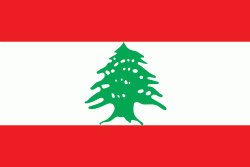Nabatieh el Tahta (Nabatîyé et Tahta)
Nabatieh (النبطية, Nabaṭiyya, ), or Nabatîyé, is the city of the Nabatieh Governorate, in southern Lebanon. The population is not accurately known as no census has been taken in Lebanon since the 1930s; estimates range from 15,000 to 120,000. A 2006 population estimate by the now-closed German population site called World Gazetteer put the population at 100,541, which would make it the fifth largest city in Lebanon, after Tyre, Sidon, Tripoli, and Beirut according to those 2006 population estimates of Lebanese cities, but after an update in either 2007 or 2008 and calculations for the following years the 2013 population estimate turned out to be much lower at 36,593 and making the city the 11th largest in Lebanon behind Tyre, Bint Jbeil, Zahlé, Sidon, Baalbek, Jounieh, Tripoli and Beirut according those 2013 estimates. It is the main city in the Jabal Amel area and the chief center for both the mohafazat, or governorate, and the kaza, or canton both also called Nabatieh. Nabatieh is an important town both economically and culturally.
A market is held every Monday where traders and visitors from neighbouring villages gather in the centre of the town to exchange their goods in an area known in Arabic as the Souq Al Tanen. There are also branches of several banks, hospitals, restaurants and cultural centres of interest to tourists. Every year, the city commemorates the Battle of Karbala to remember the martyrdom of Imam al Husayn.
Nabatieh was the birthplace of several learned men, including linguist and Arab nationalist leader Ahmad Rida, historian Muhammad Jaber Al Safa, scientist Hassan Kamel Al-Sabbah (nephew of Ahmad Rida) and theologian Sheikh Ahmed Aref El-Zein.
The town’s name originates with the Phoenician word meaning “the appearance.”
A market is held every Monday where traders and visitors from neighbouring villages gather in the centre of the town to exchange their goods in an area known in Arabic as the Souq Al Tanen. There are also branches of several banks, hospitals, restaurants and cultural centres of interest to tourists. Every year, the city commemorates the Battle of Karbala to remember the martyrdom of Imam al Husayn.
Nabatieh was the birthplace of several learned men, including linguist and Arab nationalist leader Ahmad Rida, historian Muhammad Jaber Al Safa, scientist Hassan Kamel Al-Sabbah (nephew of Ahmad Rida) and theologian Sheikh Ahmed Aref El-Zein.
The town’s name originates with the Phoenician word meaning “the appearance.”
Map - Nabatieh el Tahta (Nabatîyé et Tahta)
Map
Country - Lebanon
 |
 |
| Flag of Lebanon | |
The earliest evidence of civilization in Lebanon dates back to 5,000 BCE. From c. 3200–539 BC, it was home to the flourishing Phoenician civilization before being annexed by various Near Eastern empires. In 64 BC, the Roman Empire conquered the region, and the region became a major center for Christianity under the Byzantine Empire. In the 7th century, the Muslim conquest of the Levant established caliphal rule. The 11th century saw the start of the Crusades and the establishment of Crusader States in the region only for it to be later reclaimed by the Ayyubids and Mamluks before being ceded to the Ottoman Empire in the 16th century. Under Sultan Abdulmejid I, the first Lebanese protostate took form in the 19th century as the Mount Lebanon Mutasarrifate, created as a home for the Maronite Christians under the Tanzimat reforms.
Currency / Language
| ISO | Currency | Symbol | Significant figures |
|---|---|---|---|
| LBP | Lebanese pound | لل | 2 |
| ISO | Language |
|---|---|
| AR | Arabic language |
| HY | Armenian language |
| EN | English language |
| FR | French language |















